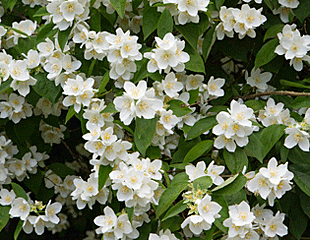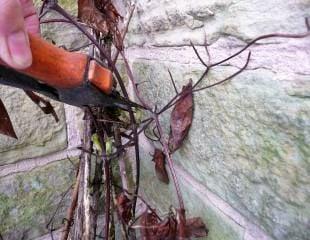
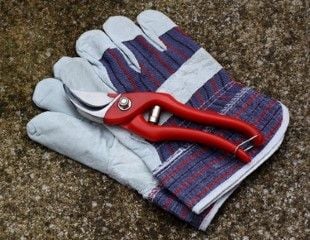
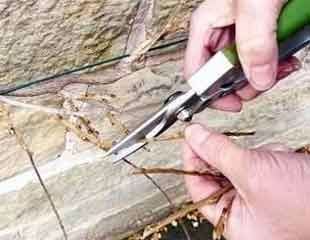
All about pruning shrubs and plants
What is the point of pruning?
Pruning is good for shrubs and plants for many reasons.
It helps to shape a plant or shrub, and to keep vigorous plants, such as Wisteria, in check.
It helps to keep the shrub healthy by removing damaged branches.
It is essential for some plants, such as Wisteria and Clematis to produce flowers. Some plants are so vigorous without a good prune they would take over.
Without pruning, some shrubs, climbing roses and Buddleja are examples, have a tendancey to produce flowers only at the top of the growth with bare bases.
Some variegated shrubs may lose their variegation on certain branches and pruning those out will help to keep its colour. This is called "reversion". It occurs when the variegated branch only produces green leaves and it is best to prune off t the non variegated branches.
Basic rules of pruning
It is important to prune at the correct time of year. Pruning a shrub is unlikely to kill it (unless you prune very hard), but you may sacrifice flowers if you prune at the wrong time. Why is this? If you prune at the wrong time, you may cut off the very branches carrying the dormant flower buds, which is why timing is so important.
It makes sense that if, for example, a shrub is going to flower in early spring, such as Forsythia, pruning it in January will remove the embryo flowers. So you really need to know what you are pruning. If you are not sure of the identity of a shrub, you can either use a plant identification app, or send a quality image to The Sunday Gardener using Free plant and shrub identification service.
Whatever you are pruning, remove any dead, spindly, or crossing branches. It also makes sense if you have a weak stem, as on a rose, it will not support the blooms, which will inevitably droop downwards.
If there is congestion in the centre of the shrub, thin it out. All plants perform best if they are not congested and have good air circulation.
The aim is to produce a balanced shape so pruning is an opportunity to check growth, and reshape a shrub.
These are general rules, and some shrubs have very specific pruning requirements.
Some of the more difficult plants to grow tend to be the ones with essential pruning requirements. Wisteria will eventually stop flowering unless pruned twice a year, which makes pruning essential. To check out how to grow and prune wisteria, details are on the growing Wisteria page, and there are three videos: how to do the summer and winter pruning, and how to make your wisteria flower.
Clematis have fussy pruning requirements as well, for all but the early flowering varieties. If you don't like pruning, the best clematis for you to grow are the early flowering types such as Montana, Alpina, Cirrhosa, or the slightly tender, sweet smelling C.Armandii. These early flowering Clematis do not need any pruning.
Clematis fall into three groups which determine when they should be pruned. Don't know which group of Clematis you have? Check out video about how to prune an unknown variety of Clematis.
, the early flowering Clematis are group 1 which do not require pruning but Groups 2 & 3 do; full details are on the growing Clematis page and videos
For most pruning, it is best grouped into when to prune.
Pruning By Season - What to prune and when
Winter prune in February
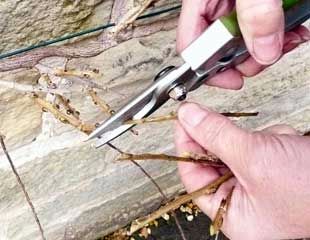
Winter - as in January and February, is the time to prune Roses, namely climbing roses, Floridundas, Hybrid tea but not ramblers.
Prune also Groups 2 & 3 Clematis
For best winter colour next year Coppice Cornus.
Video how to do this plus before and after images.
Whatever you are pruning it is always best done during a mild spell in winter.
February is also the time to prune Wisteria and to give it an essential winter prune, without which it's flowering will reduce.
How to winter prune wisteria advice and video.
Spring pruning
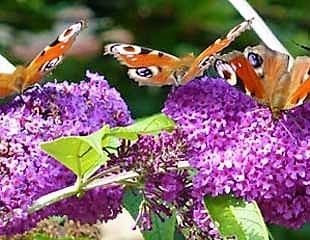
Spring, principally March and April, is a busy time for pruning. Prune those deciduous shrubs which produce flowers on new growth, and midsummer onwards, such as Buddleja davidii, french lavender, Lavatera and Hebes.
Herbaceous perennials where the seed heads have been left in place or the top growth to protect the plant can be cut back now such as grasses, sedum and salvia.
Prune winter-flowering shrubs such as Lonicera, Jasmine nudiflorum (winter jasmine), and Viburnum shrubs such as x bodnantense after they finish flowering.
Prune Mahonia and Hydrangea paniculata.
Prune Bush and Shrub Roses, following the basic rules above.
Summer Pruning
Prune any of the Spring flowering shrubs which have finished flowering such as Philadelphus, Forsythia, Ceanothus and Deutzia.
Fruit trees, Apples, Cherries, Plums and Pears.
You can prune hedges, but ensure no birds are nesting. Destruction of a nest can be an offence under the Wildlife and Countryside Act 1981. check and prune Beech and Hornbeam, Box, Leylandii, Thuja, Privet and Laurel.
Autumn Pruning
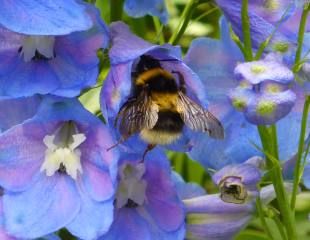
After flowering Herbaceous perennials can be tidied up by pruning. This group includes Delphiniums, Thalictrum, Peonies, Phlox, Achillea, Geraniums.
You can trim and tidy English Lavender and Santolina, common name Cotton Lavender and Rosemary.
This later time in the year is ideal for pruning Taxux, the Yew.

